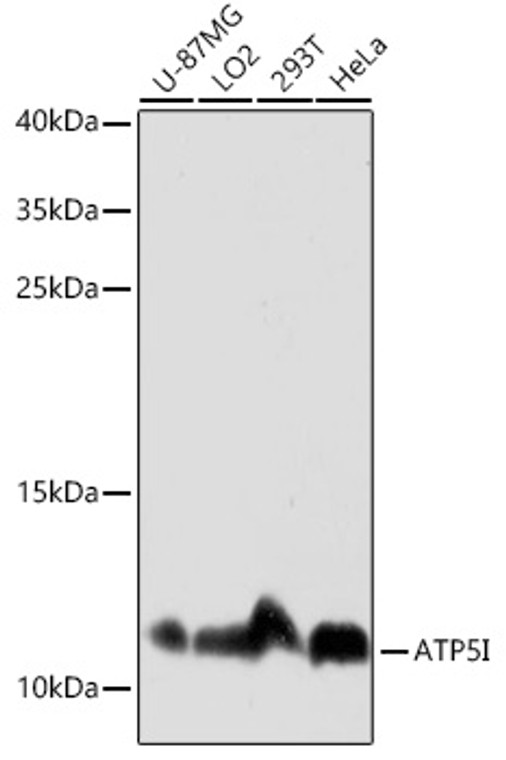| Host: |
Rabbit |
| Applications: |
WB/IHC/IF |
| Reactivity: |
Human/Mouse/Rat |
| Note: |
STRICTLY FOR FURTHER SCIENTIFIC RESEARCH USE ONLY (RUO). MUST NOT TO BE USED IN DIAGNOSTIC OR THERAPEUTIC APPLICATIONS. |
| Short Description: |
Rabbit polyclonal antibody anti-ATP5I (1-69) is suitable for use in Western Blot, Immunohistochemistry and Immunofluorescence research applications. |
| Clonality: |
Polyclonal |
| Conjugation: |
Unconjugated |
| Isotype: |
IgG |
| Formulation: |
PBS with 0.01% Thimerosal, 50% Glycerol, pH7.3. |
| Purification: |
Affinity purification |
| Dilution Range: |
WB 1:500-1:2000IHC-P 1:50-1:200IF/ICC 1:50-1:200 |
| Storage Instruction: |
Store at-20°C for up to 1 year from the date of receipt, and avoid repeat freeze-thaw cycles. |
| Gene Symbol: |
ATP5ME |
| Gene ID: |
521 |
| Uniprot ID: |
ATP5I_HUMAN |
| Immunogen Region: |
1-69 |
| Immunogen: |
Recombinant fusion protein containing a sequence corresponding to amino acids 1-69 of human ATP5I (NP_009031.1). |
| Immunogen Sequence: |
MVPPVQVSPLIKLGRYSALF LGVAYGATRYNYLKPRAEEE RRIAAEEKKKQDELKRIARE LAEDDSILK |
| Function | Mitochondrial membrane ATP synthase (F(1)F(0) ATP synthase or Complex V) produces ATP from ADP in the presence of a proton gradient across the membrane which is generated by electron transport complexes of the respiratory chain. F-type ATPases consist of two structural domains, F(1) - containing the extramembraneous catalytic core, and F(0) - containing the membrane proton channel, linked together by a central stalk and a peripheral stalk. During catalysis, ATP synthesis in the catalytic domain of F(1) is coupled via a rotary mechanism of the central stalk subunits to proton translocation. Part of the complex F(0) domain. Minor subunit located with subunit a in the membrane. |
| Protein Name | Atp Synthase Subunit E - MitochondrialAtpase Subunit EAtp Synthase Membrane Subunit E Cleaved Into - Atp Synthase Subunit E - Mitochondrial - N-Terminally Processed |
| Database Links | Reactome: R-HSA-163210Reactome: R-HSA-8949613 |
| Cellular Localisation | MitochondrionMitochondrion Inner Membrane |
| Alternative Antibody Names | Anti-Atp Synthase Subunit E - Mitochondrial antibodyAnti-Atpase Subunit E antibodyAnti-Atp Synthase Membrane Subunit E Cleaved Into - Atp Synthase Subunit E - Mitochondrial - N-Terminally Processed antibodyAnti-ATP5ME antibodyAnti-ATP5I antibodyAnti-ATP5K antibody |
Information sourced from Uniprot.org
12 months for antibodies. 6 months for ELISA Kits. Please see website T&Cs for further guidance









